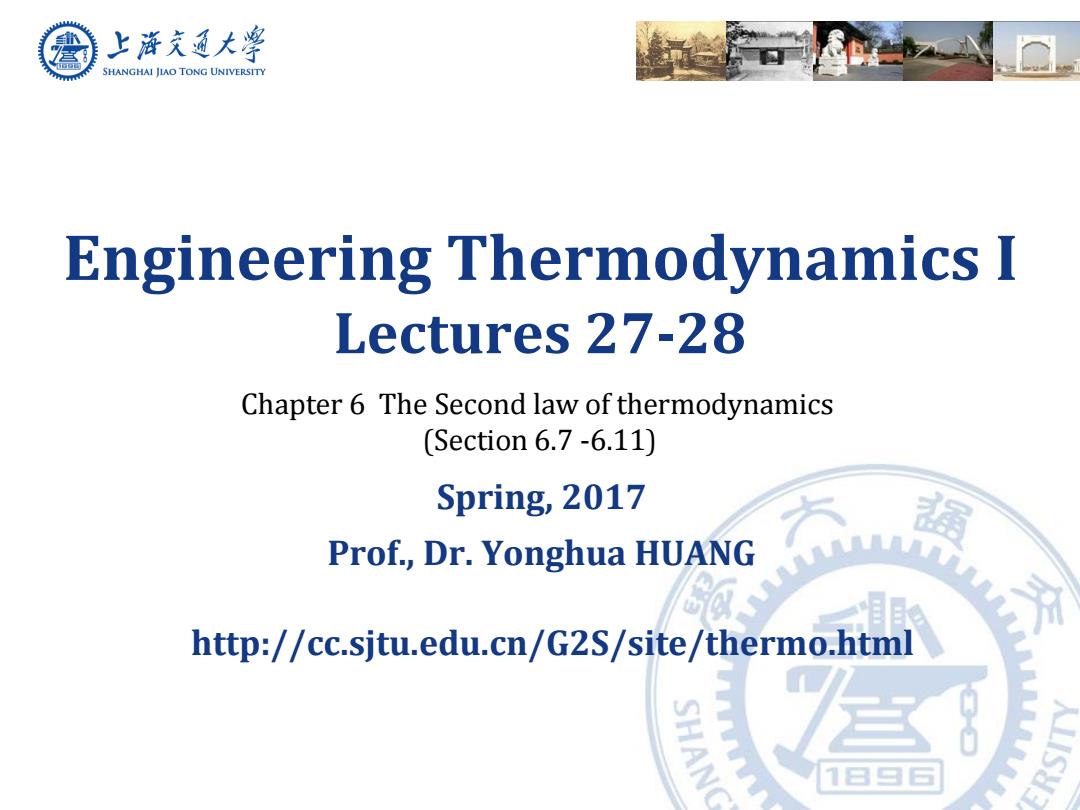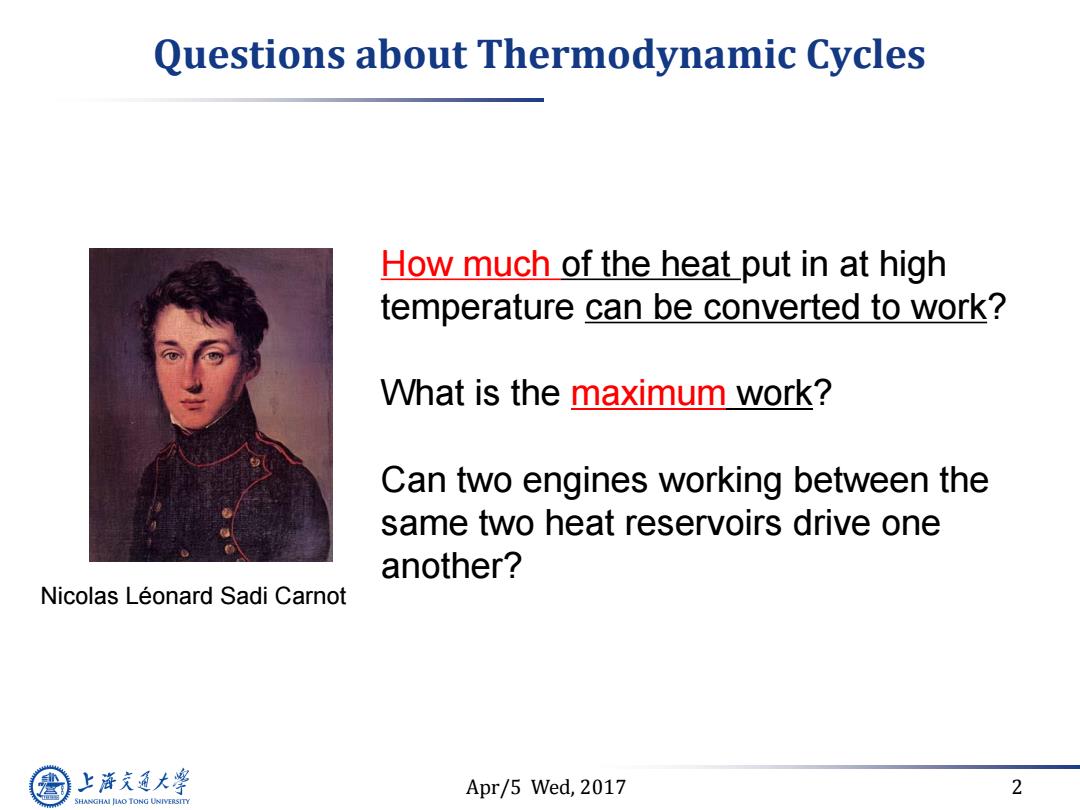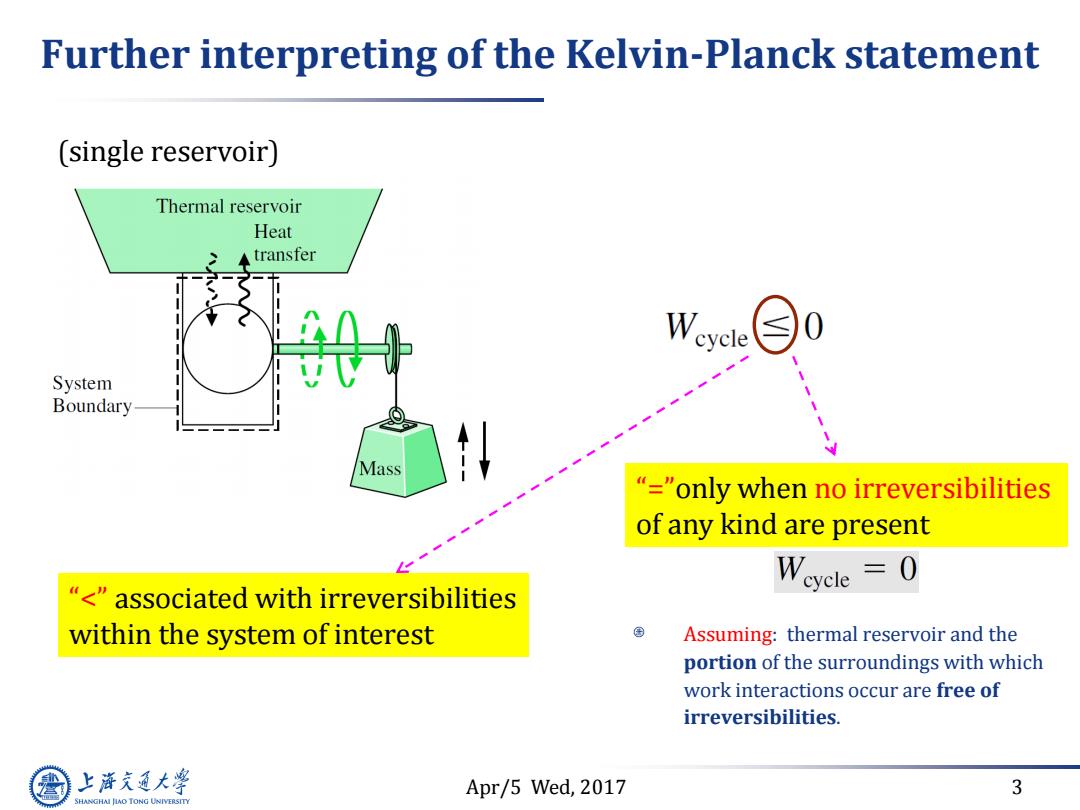
上游充通大¥ SHANGHAI JIAO TONG UNIVERSITY Engineering Thermodynamics I Lectures 27-28 Chapter 6 The Second law of thermodynamics (Section 6.7-6.11) Spring,2017 强 Prof.,Dr.Yonghua HUANG 月是a http://cc.sjtu.edu.cn/G2S/site/thermo.html 1日G
Engineering Thermodynamics I Lectures 27-28 Spring, 2017 Prof., Dr. Yonghua HUANG Chapter 6 The Second law of thermodynamics (Section 6.7 -6.11) http://cc.sjtu.edu.cn/G2S/site/thermo.html

Questions about Thermodynamic Cycles How much of the heat put in at high temperature can be converted to work? What is the maximum work? Can two engines working between the same two heat reservoirs drive one another? Nicolas Leonard Sadi Carnot 上游究通大学 Apr/5 Wed,2017 2 SHANGHAI JLAO TONG UNIVERSITY
Apr/5 Wed, 2017 2 Questions about Thermodynamic Cycles How much of the heat put in at high temperature can be converted to work? What is the maximum work? Can two engines working between the same two heat reservoirs drive one another? Nicolas Léonard Sadi Carnot

Further interpreting of the Kelvin-Planck statement (single reservoir) Thermal reservoir Heat Atransfer W ycle System Boundary Mass "="only when no irreversibilities of any kind are present "<"associated with irreversibilities within the system of interest Assuming:thermal reservoir and the portion of the surroundings with which work interactions occur are free of irreversibilities. 上游充通大 Apr/5 Wed,2017 3 SHANGHAI JIAO TONG UNIVERSITY
Apr/5 Wed, 2017 3 Further interpreting of the Kelvin-Planck statement Assuming: thermal reservoir and the portion of the surroundings with which work interactions occur are free of irreversibilities. “<” associated with irreversibilities within the system of interest “=”only when no irreversibilities of any kind are present (single reservoir)

Single reservoir Two reservoir Power Cycles Interacting with Two Reservoirs Hot reservoir Any substance, And process Boundary ◆Weycle=QH-Qc Cold reservoir Qc=0今n=1→Wycle=QH Thermal efficiency of the cycle: violate the Kelvin-Planck statement Gain n= =1- Cost C CH Must discharge Qc Weycle<QH,n≤100% 上游充通大 Apr/5 Wed,2017 4 SHANGHAI JLAO TONG UNIVERSITY
Apr/5 Wed, 2017 4 Single reservoir Two reservoir Power Cycles Interacting with Two Reservoirs Thermal efficiency of the cycle: QC=0 η =1 Wcycle = QH violate the Kelvin–Planck statement • Must discharge QC • Wcycle < QH , η<100% Any substance, And process Gain Cost

Carnot corollaries n<100%>what's the maximum theoretical efficiency? Less work The thermal efficiency of an irreversible power cycle is always less than the thermal efficiency of a reversible power cycle when each operates between the same two thermal reservoirs. Not“same△T<-- All reversible power cycles operating between the same two thermal reservoirs have the same thermal efficiency. Consistent with the Kelvin-Planck statement 上游充通大学 Apr/5 Wed,2017 5 SHANGHAI JIAO TONG UNIVERSITY
Apr/5 Wed, 2017 5 Carnot corollaries η<100% what’s the maximum theoretical efficiency? • The thermal efficiency of an irreversible power cycle is always less than the thermal efficiency of a reversible power cycle when each operates between the same two thermal reservoirs. • All reversible power cycles operating between the same two thermal reservoirs have the same thermal efficiency. Not “same ΔT” Less work Consistent with the Kelvin-Planck statement 1 2